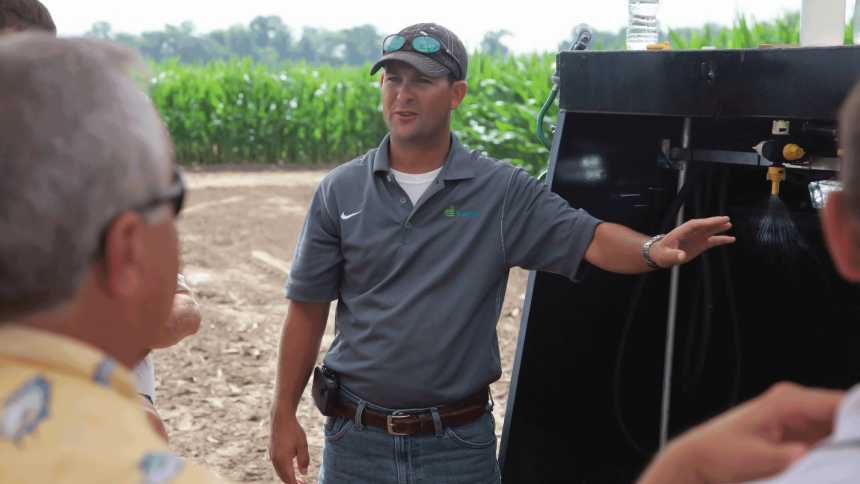Guiding New Herbicide Systems’ Launches

A sprayer table demonstration describes how new cropping systems will work.
While Dow AgroSciences and Monsanto may be waiting for final approval for their herbicide-tolerant varieties in a number of countries, company representatives will still be plenty busy this summer.
To recap: DowAgroSciences received USDA approval for Enlist corn and soybeans in September — and EPA registration for Enlist Duo herbicide (2,4-D choline and glyphosate) in October. Regulatory approvals are pending for Enlist cotton.
Just in January, Monsanto received USDA approval for its Roundup Ready 2 Xtend soybeans and Bollgard II XtendFlex cotton. The company is awaiting EPA registration for its Roundup Xtend herbicide (dicamba and glyphosate).
The Season Ahead
Dow AgroSciences will launch Enlist Duo this summer in conjunction with “stewarded” 1) introduction of Enlist corn and 2) seed production of Enlist soybeans.
What will that look like? At presstime, Dow AgroSciences was talking with corn growers in the six states Enlist Duo is registered in (Illinois, Indiana, Iowa, Ohio, South Dakota and Wisconsin) to find farmers who can fulfill the requirements of the stewarded launch. John Kalthoff, cross-platform portfolio marketing leader, says some of the protocols of this particular introduction are unique. For instance, growers must provide a 660-foot isolation perimeter around Enlist corn fields — no other corn can be grown in that area. In addition, the crop must be grown for on-farm feed only.
The purpose of such restrictive guidelines is to keep any Enlist corn out of the grain channel, to ensure it doesn’t get sent to countries that have not approved the traits.
In Enlist soybeans, Dow AgroSciences will continue its Field Forward program. Enlist soybean fields will be tightly managed by the company’s seed production group, and here again, participating growers follow a very rigorous protocol to steward that seed, says Kalthoff. “We need every single seed. Not only do we not want it to get into the grain channel, but we need to keep that seed for future sale,” he explains.
The fields will include both Enlist soybeans with Roundup Ready 2 Yield and Enlist E3 soybeans (developed with MS Technologies). Enlist E3 soybeans offer tolerance to glyphosate, Dow’s new 2,4-D and glufosinate.
For Monsanto’s Roundup Ready 2 Xtend soybeans, John Combest, media communications manager, crop protection and applications, expects around 100 farmers to participate in the company’s Ground Breakers Field Trials Under Permit. This program gives farmers first-hand experience with new technology prior to commercialization. These farmers are actually a subset of the overall number of farmers growing production seed for the Roundup Ready 2 Xtend soybeans.
Monsanto’s Bollgard II XtendFlex cotton is also being introduced on more than 500,000 acres this summer. Plus, about 200 growers will be participating in Deltapine’s New Product Evaluator Program, which marks the final stage of the firm’s variety testing and will ultimately determine the Bollgard II XtendFlex varieties that will be available during full product launch in 2016.
Learning Opportunities
To prepare for commercialization of the Roundup Ready Xtend Crop System in soybeans and cotton, Monsanto has trained more than 7,500 growers, retail partners and stakeholders since education efforts began in summer 2012.
In 2015, there will be more in-field training available to growers and retailers, which will include Roundup Ready Learning Xperience sites and the Ground Breakers Field Trial Under Permit program. Combest expects that both the number of Ground Breakers sites and the growers participating in the program to just about double in 2015.
During this year’s commercial introduction of Bollgard II XtendFlex cotton, Monsanto is focusing training in three key areas. The first is variety placement and management. The company has varieties to fit all major cotton-growing regions, so representatives’ primary focus is to help growers choose the varieties that best fit their farms.
“Second, we’ll be making weed control recommendations on effective use of Roundup brand herbicides, Liberty herbicide and other approved residual herbicides,” says Combest.
Lastly, Monsanto is working to ensure stewardship using labeled product. That means the company has a clear message that in-crop application of dicamba herbicides is not authorized in 2015, he explains.
This summer, Dow AgroSciences will continue its Enlist Ahead management program, which shows growers and retailers best management practices for the system. For the past two years, thousands of growers/retailers have had face-to-face learning opportunities at summer technology demonstration sites. As well as stewardship information, the sites showcased the system’s weed control capabilities.
Kalthoff explains that this year’s field training for Enlist will cover the three components of the system: viewing of the crops themselves (corn, soybeans and cotton); application of Enlist Duo herbicide, with special focus on how the Colex-D Technology reduces drift and volatility; and demonstration of the Enlist Ahead management resource.
For 2015, Dow’s stewarded introduction of Enlist corn will be much larger than prior years’ experience plots — and take the crop all the way through full yield. Retailers interested in selling Enlist Duo herbicide will also be able to take online Enlist 360 Seller training. The site is not ready for access yet but will be in time for dealers who will carry the product in 2015.
Retailers’ Perspective
Jeff Bunting, crop protection division manager with GROWMARK, Mahomet, IL, says his team will participate in training for both systems. Instruction will involve risk mitigation from ticket creation, field awareness, mixing and handling, application from container to droplet and cleanout procedures.
“We still have a lot to learn. When you move from greenhouse, to small plots, to large fields at each step there is always something learned from a challenge or weakness,” he says. “It’s hard to know what you don’t know and that comes with a small targeted launch. Everyone can build their confidence in the product.”
Some retailers CropLife® editors have talked with over the past year or so are concerned growers may view the new systems as a one-stop solution to manage weeds, much as glyphosate-resistant products have been treated.
“It’s important to note that dicamba is not a ‘silver bullet’ to manage weeds,” says Monsanto’s Combest. “Growers must still incorporate diversified weed management practices (DWMPs), including using other residual herbicides.” He suggests users visit RoundupReadyPLUS.com for specific recommendations for their area.
By offering an additional mode of action, dicamba offers soybean growers another tool to control glyphosate-resistant and other tough-to-control broadleaf weeds, says Combest. Dicamba also allows growers to expand application flexibility to before, at, and after planting, and can provide residual weed control up to 14 days on small seeded broadleaf weeds, depending on rainfall and soil conditions.
In cotton, the Bollgard II XtendFlex varieties also allow farmers to use not only dicamba and glyphosate, but also glufosinate (Liberty) herbicides over the top of their crop.
“At Enlist 360 training, we emphasize the importance of implementing weed resistance management practices, including the use of multiple modes of action in a program approach to weed control,” says Dow AgroSciences’ Kalthoff. “It could include applying a residual, soil-applied herbicide preemergence, such as SureStart II herbicide in corn or Sonic herbicide in soybeans, followed by a postemergence application of Enlist Duo.”






